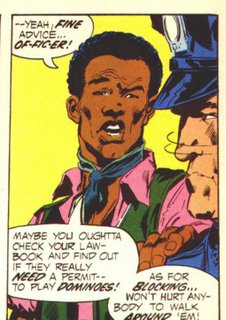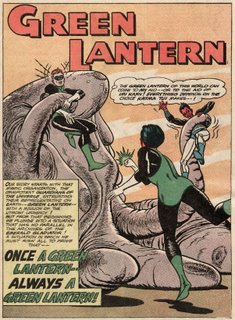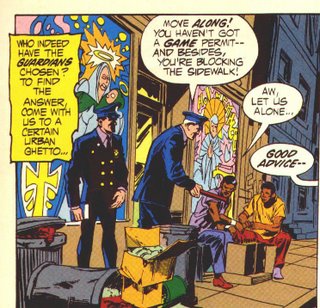I wasn't going to keep doing this, but the yellow background is nagging at me. Anywhere else, I'd accept that it's a random color. But this is a panel found in
Green Lantern. For 30 years, this was the sole weakness of
Green Lantern. Their powers were unable to affect anything
yellow (Please note the date on that linked post). Yellow is not cavalierly thrown around in this franchise. It's usually there as a means of hurting the main character. It's been there as a mistake, which made Superfriends interesting ("Everytime Green Lantern's ring affects yellow, take a shot").
Sometimes, though, its symbolic. It's the color of the ground on an alien planet, the background of choice for a villain, or the color of an ex-girlfriend's scarf. It can be representative of limitations, weaknesses, vulnerabilities, restrictions, or fears.

This is the first time we get to see John. He is about to be inducted into the Green Lantern Corps, and he is surrounded by yellow. I'm not sure what to make of it. I find it hard to believe that, for a new Lantern's first appearance, they would just arbitrarily pick a "Yellow Background."
There's other subtleties here.
This is the second panel of the page. Right away, any comic book reader knows to chuck the standard superhero image out the door in this setup. The standard would have shown up in the first panel, because why create even minor suspense for what's expected anyway? For a huge surprise, someone we've seen before and have reason not to expect, it's traditional to make the reader turn the page. Here, it's just a panel. O'Neil held off just long enough so that we'd pause and think about what we read and saw
before we actually see the new guy. This is a new personed, but this will not be someone like Hal. Most likely, judging by the
language of the first panel, this will be someone at odds with Hal.
I think the intended effect of that pause is lost on today's readers. We don't really have a good representation of the American population in regular DC comics yet, but it's a lot better than back then. At this point in time, 1972, it was probably unheard of to bring in a different race as a replacement. So, even with the previous panel, a reader was probably expecting a white man, even with second panel introduction. Probably an activist who'd be at odds with Green Lantern like Green Arrow was, but still with a certain look.
There's not much extra in the panel, they didn't want us to get distracted from John himself. We do learn a lot about him in the first glimpse. Nevertheless, we can learn quit a bit about the man here.
We learn he's a sarcastic smartass who doesn't automatically grant his respect to a scary uniform by his words alone. His sneer and the tilt of his head add a condescending dismissal to this.
We learn he's dumb enough to approach an armed policeman from behind, and
touch his shoulder. You don't do that, even joking, without immediately hitting the pavement. (This was just a particularly crummy cop all-around)
He's man enough to wear pink.
He's got a sense of fairness, justice and the courage to step in when he sees an authority figure abusing their authority (again, refer back to the
first panel, the sidewalk is not being blocked). Even when he is in all likelihood about to get in
severe trouble for it. I can see how Katma Tui, a native of Korugar from when it was under Sinestro's Totalitarian Regime, would be so much more attacted to John than Hal. Hal's a "work with the system" type, his courage is physical. John's social courage is so much more impressive to a woman of Kat's background.
Yet, the yellow background still eludes me. Does it mean that he's leaving restrictions and limitations
behind him now? Or does it represent a certain fear that accompanies his actions? He's doing a very brave, but very
stupid thing here when he comes up behind a cop who's abusing his authority. Does the yellow in the background subtly tell us that John recognizes his actions, knows the consequences, and is leaving his fears behind him?
It could simply be foreshadowing the rocky start to his relationship with Hal. They start off fine as trainer and trainee, but there's a barrier created by unspoken feelings. The obvious cause for the barrier (particularly in
this run of
Green Lantern) is prejudice. I picked up this story
expecting an After School Special about racism. But that level of characterization is actually quite subtle. It exists, and surfaces, but there is a much more overt character conflict that causes the barrier. Hal and John have separate values. Hal's worship of Authority is well-established by this point in O'Neil's run. John's attitude towards authority is immediately established in this panel. Hal is placed in authority over John as his trainer, and Hal is witnessing this scene as
his first impression of John. Ther judgement is there on both appearance and character. The racial prejudice is a much more obvious problem. It's something both men want to avoid, they don't want to confront this attitude. As a result, the major disagreement, the dissenting values, goes unexplored and unresolved. This creates an undercurrent of tension between the two that lasts much of the John's initial training, until the plot of the story interferes and forces both conflicts to the surface.
Because most of the barrier on Hal's side is caused by this first impression, it's very sensible to introduce John surrounded by a color that presents a barrier to Hal's powers.






